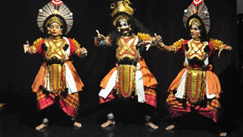

11th April 2022 (6 Topics)
Context
Today’s young artists are quite fascinated with the traditional theatre form of Yakshagana.
About
About Yakshagana:
- Yakshagana is a traditional theatre form that combines dance, music, dialogue, costume, make-up, and stage techniques with a unique style and form.
- Yakshagana literally means the song (gana) of the yaksha (nature spirits).
- It developed in Udupi, in the state of Karnataka. It is popular in the Karnataka districts of Dakshina Kannada, Kasaragod, Udupi, Uttara Kannada and Shimoga.
- This folk art is believed to have originated somewhere in between the 10th and 16th century.
- It is performed with percussion instruments like chenda, maddalam, jagatta or chengila (cymbals) and chakratala or elathalam (small cymbals).
- Theme:Yakshagana is strongly influenced by the Vaishnava Bhakti movement. Its stories are mainly drawn from Ramayana, Mahabharata, Bhagavata and other Hindu epics.
- The Dress: Costumes used in Yakshagana are very unique and elaborate. Large size head gear, coloured faces, elaborate costumes all over the body and musical beads on the legs (Gejje). Performers need great physique to perform with heavy costume for several hours and also strong voice and acting/dancing skills.
- Key Features:
- A typical Yakshagana performance consists of background music played by a group of musicians (known as the himmela); and a dance and dialog group (known as the mummela), who together enact poetic epics on stage.
- Yakshagana is traditionally presented from dusk to dawn.
- Types:
- The tenkutittu style: It is prevalent in Dakshina Kannada. Tenkutittu is noted for its incredible dance steps; its high flying dance moves; and its extravagant rakshasas (demons).
- The Badagutittu style: It is prevalent in Uttara Kannada District and places more emphasis on facial expressions, matugarike (dialogues), and dances appropriate for the character depicted in the episode.

More Articles



